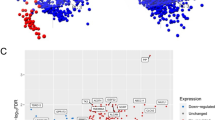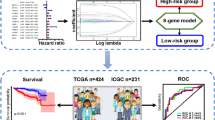Abstract
Background
The altered long non-coding RNA (lncRNA), circular RNA (circRNA) and mRNA expression in triple-negative breast cancer (TNBC) after pirarubicin (THP) treatment can be a critical factor in the development of tumor. Here, we identify a set of lncRNA, circRNA, and mRNA that can reveal the molecular target and molecular mechanism of THP, and can be used to predict the prognostic characteristics of TNBC.
Methods
Affymetrix GeneChip sequencing was performed to determine whether lncRNA, circRNA, and mRNA were changed in MDA-MB-231 cells after THP treatment, and qRT-PCR was used to verify the accuracy of GeneChip results. Bioinformatics methods were used to analyze the differentially expressed (DE) lncRNA, circRNA and mRNA, and the co-expression network and ceRNA network were constructed. The STRING database, Kaplan–meier Mapper database, GEPIA database, and Tumor Immunity Estimation Resource were used to screen hub genes with clinical value and important significance.
Results
THP 5 μM could significantly inhibit proliferation, migration and invasion of MDA-MB-231 cells for 24 h. 1547 DE lncRNAs, 4992 DE circRNAs, and 5777 DE mRNAs were identified. The reliability of the GeneChip was verified by qRT-PCR. An mRNA-lncRNA/circRNA co-expression network was constructed based on the Pearson correlation coefficient. Finally, we established a new ceRNA network, including three circRNAs, five miRNAs, and three mRNAs. The mRNAs are associated with immune infiltration. The mRNAs and miRNAs are significantly associated with survival outcomes in TNBC.
Conclusion
The results reveal the molecular target and mechanism of THP treatment of TNBC. These ceRNA network can be used as molecular targets for the treatment of TNBC patients and as molecular biomarkers to predict patient prognosis.






Similar content being viewed by others
Data availability
Additional data pertaining to this work can be obtained from the corresponding author upon request.
References
Sung H, Ferlay J, Siegel RL, Laversanne M, Soerjomataram I, Jemal A, Bray F. Global Cancer Statistics 2020: GLOBOCAN estimates of incidence and mortality worldwide for 36 cancers in 185 Countries. CA Cancer J Clin. 2021;71:209–49.
Hortobagyi GN, Edge SB, Giuliano A. New and important changes in the TNM staging system for breast cancer. Am Soc Clin Oncol Educat Book. 2018;38:457–67.
Li C-J, Tzeng Y-DT, Chiu Y-H, Lin H-Y, Hou M-F, Chu P-Y. Pathogenesis and potential therapeutic targets for triple-negative breast cancer. Cancers. 2021;13:2978.
Mezi S, Botticelli A, Pomati G, Cerbelli B, Scagnoli S, Amirhassankhani S, D’Amati G, Marchetti P. Standard of care and promising new agents for the treatment of mesenchymal triple-negative breast cancer. Cancers. 2021;13:1080.
Liao M, Zhang J, Wang G, Wang L, Liu J, Ouyang L, Liu B. Small-molecule drug discovery in triple negative breast cancer: current situation and future directions. J Med Chem. 2021;64:2382–418.
Angsutararux P, Luanpitpong S, Issaragrisil S. Chemotherapy-induced cardiotoxicity: overview of the roles of oxidative stress. Oxid Med Cell Longev. 2015;2015: 795602.
Cech TR, Steitz JA. The noncoding RNA revolution-trashing old rules to forge new ones. Cell. 2014;157:77–94.
Venkatesh T, Suresh PS, Tsutsumi R. Non-coding RNAs: functions and applications in endocrine-related cancer. Mol Cell Endocrinol. 2015;416:88–96.
Wang J, Zhang Y, Liu L, Yang T, Song J. Circular RNAs: new biomarkers of chemoresistance in cancer. Cancer Biol Med. 2021;18:421–36.
Han J, Han B, Wu X, Hao J, Dong X, Shen Q, Pang H. Knockdown of lncRNA H19 restores chemo-sensitivity in paclitaxel-resistant triple-negative breast cancer through triggering apoptosis and regulating Akt signaling pathway. Toxicol Appl Pharmacol. 2018;359:55–61.
Kartha RV, Subramanian S. Competing endogenous RNAs (ceRNAs): new entrants to the intricacies of gene regulation. Front Genet. 2014;5:8.
Salmena L, Poliseno L, Tay Y, Kats L, Pandolfi PP. A ceRNA hypothesis: the Rosetta Stone of a hidden RNA language? Cell. 2011;146:353–8.
Zheng SR, Huang QD, Zheng ZH, Zhang ZT, Guo GL. circGFRA1 affects the sensitivity of triple-negative breast cancer cells to paclitaxel via the miR-361-5p/TLR4 pathway. J Biochem. 2021;169:601–11.
The Gene Ontology resource: enriching a GOld mine. Nucleic Acids Res. 2021;49:D325-d334.
Kanehisa M, Sato Y, Kawashima M, Furumichi M, Tanabe M. KEGG as a reference resource for gene and protein annotation. Nucleic Acids Res. 2016;44:D457-462.
Györffy B, Lanczky A, Eklund AC, Denkert C, Budczies J, Li Q, Szallasi Z. An online survival analysis tool to rapidly assess the effect of 22,277 genes on breast cancer prognosis using microarray data of 1809 patients. Breast Cancer Res Treat. 2010;123:725–31.
Lánczky A, Nagy Á, Bottai G, Munkácsy G, Szabó A, Santarpia L, Győrffy B. miRpower: a web-tool to validate survival-associated miRNAs utilizing expression data from 2178 breast cancer patients. Breast Cancer Res Treat. 2016;160:439–46.
Tang Z, Li C, Kang B, Gao G, Li C, Zhang Z. GEPIA: a web server for cancer and normal gene expression profiling and interactive analyses. Nucleic Acids Res. 2017;45:W98–102.
Li T, Fan J, Wang B, Traugh N, Chen Q, Liu JS, Li B, Liu XS. TIMER: a web server for comprehensive analysis of tumor-infiltrating immune cells. Cancer Res. 2017;77:e108–10.
Li B, Severson E, Pignon JC, Zhao H, Li T, Novak J, Jiang P, Shen H, Aster JC, Rodig S, et al. Comprehensive analyses of tumor immunity: implications for cancer immunotherapy. Genome Biol. 2016;17:174.
Dudekula DB, Panda AC, Grammatikakis I, De S, Abdelmohsen K, Gorospe M. CircInteractome: a web tool for exploring circular RNAs and their interacting proteins and microRNAs. RNA Biol. 2016;13:34–42.
Li JH, Liu S, Zhou H, Qu LH, Yang JH. starBase v2.0: decoding miRNA-ceRNA, miRNA-ncRNA and protein-RNA interaction networks from large-scale CLIP-Seq data. Nucleic Acids Res. 2014;42:D92-97.
Shannon P, Markiel A, Ozier O, Baliga NS, Wang JT, Ramage D, Amin N, Schwikowski B, Ideker T. Cytoscape: a software environment for integrated models of biomolecular interaction networks. Genome Res. 2003;13:2498–504.
Cao X, Luo J, Gong T, Zhang ZR, Sun X, Fu Y. Coencapsulated doxorubicin and bromotetrandrine lipid nanoemulsions in reversing multidrug resistance in breast cancer in vitro and in vivo. Mol Pharm. 2015;12:274–86.
Schlessinger J. Receptor tyrosine kinases: legacy of the first two decades. Cold Spring Harb Perspect Biol. 2014;6:a008912.
Oshi M, Gandhi S, Tokumaru Y, Yan L, Yamada A, Matsuyama R, Ishikawa T, Endo I, Takabe K. Conflicting roles of EGFR expression by subtypes in breast cancer. Am J Cancer Res. 2021;11:5094–110.
Kyriakopoulou K, Kefali E, Piperigkou Z, Riethmüller C, Greve B, Franchi M, Götte M, Karamanos NK. EGFR is a pivotal player of the E2/ERβ - mediated functional properties, aggressiveness, and stemness in triple-negative breast cancer cells. Febs j. 2022;289:1552–74.
Liu X, Adorno-Cruz V, Chang YF, Jia Y, Kawaguchi M, Dashzeveg NK, Taftaf R, Ramos EK, Schuster EJ, El-Shennawy L, et al. EGFR inhibition blocks cancer stem cell clustering and lung metastasis of triple negative breast cancer. Theranostics. 2021;11:6632–43.
Gu Y, Liu Y, Fu L, Zhai L, Zhu J, Han Y, Jiang Y, Zhang Y, Zhang P, Jiang Z, et al. Tumor-educated B cells selectively promote breast cancer lymph node metastasis by HSPA4-targeting IgG. Nat Med. 2019;25:312–22.
Guestini F, Ono K, Miyashita M, Ishida T, Ohuchi N, Nakagawa S, Hirakawa H, Tamaki K, Ohi Y, Rai Y, et al. Impact of topoisomerase IIα, PTEN, ABCC1/MRP1, and KI67 on triple-negative breast cancer patients treated with neoadjuvant chemotherapy. Breast Cancer Res Treat. 2019;173:275–88.
Bao C, Liu T, Qian L, Xiao C, Zhou X, Ai H, Wang J, Fan W, Pan J. Shikonin inhibits migration and invasion of triple-negative breast cancer cells by suppressing epithelial-mesenchymal transition via miR-17-5p/PTEN/Akt pathway. J Cancer. 2021;12:76–88.
Uzelac B, Krivokuca A, Brankovic-Magic M, Magic Z, Susnjar S, Milovanovic Z, Supic G. Expression of SIRT1, SIRT3 and SIRT6 genes for predicting survival in triple-negative and hormone receptor-positive subtypes of breast cancer. Pathol Oncol Res. 2020;26:2723–31.
Podralska M, Ziółkowska-Suchanek I, Żurawek M, Dzikiewicz-Krawczyk A, Słomski R, Nowak J, Stembalska A, Pesz K, Mosor M. Genetic variants in ATM, H2AFX and MRE11 genes and susceptibility to breast cancer in the polish population. BMC Cancer. 2018;18:452.
Lu J, Wei Q, Bondy ML, Brewster AM, Bevers TB, Yu TK, Buchholz TA, Meric-Bernstam F, Hunt KK, Singletary SE, Wang LE. Genetic variants in the H2AFX promoter region are associated with risk of sporadic breast cancer in non-Hispanic white women aged <or=55 years. Breast Cancer Res Treat. 2008;110:357–66.
Du W, Hu J, Hu R, Yang M, Peng Y, Zhang Z, Li Y, He X. circ0101675 promotes malignant process via sponging miR-1278 and upregulating WNT3A/5A in non-small cell lung cancer. J Cancer. 2021;12:4209–17.
Rong Z, Shi S, Tan Z, Xu J, Meng Q, Hua J, Liu J, Zhang B, Wang W, Yu X, Liang C. Circular RNA CircEYA3 induces energy production to promote pancreatic ductal adenocarcinoma progression through the miR-1294/c-Myc axis. Mol Cancer. 2021;20:106.
Li H, Li HH, Chen Q, Wang YY, Fan CC, Duan YY, Huang Y, Zhang HM, Li JP, Zhang XY, et al. miR-142-5p inhibits cell invasion and migration by targeting DNMT1 in breast cancer. Oncol Res. 2022;28:885–97.
Hua B, Li Y, Yang X, Niu X, Zhao Y, Zhu X. MicroRNA-361-3p promotes human breast cancer cell viability by inhibiting the E2F1/P73 signalling pathway. Biomed Pharmacother. 2020;125: 109994.
Hu S, Song Y, Zhou Y, Jiao Y, Wang S. MiR-1270 suppresses the malignant progression of breast cancer via targeting MMD2. J Healthc Eng. 2022;2022:3677720.
Hao J, Du X, Lv F, Shi Q. Knockdown of circ_0006528 suppresses cell proliferation, migration, invasion, and adriamycin chemoresistance via regulating the miR-1236-3p/CHD4 axis in breast cancer. J Surg Res. 2021;260:104–15.
Author information
Authors and Affiliations
Contributions
JM, YZ, LR conceived and designed experiments. JM performed experiments. CC and FW carried out data analysis. JJ, PH, and DW participated in the preparation of reagents/materials/analysis tools. JM wrote the manuscript. YZ, LR supervised the manuscript. All data were generated in-house, and no paper mill was used. All authors agree to be accountable for all aspects of this work including the integrity and accuracy of the data presented.
Corresponding authors
Ethics declarations
Conflict of interest
The authors have no competing interests to declare.
Additional information
Publisher's Note
Springer Nature remains neutral with regard to jurisdictional claims in published maps and institutional affiliations.
Supplementary Information
Below is the link to the electronic supplementary material.
About this article
Cite this article
Ma, J., Wang, F., Chen, C. et al. Identification of prognostic genes signature and construction of ceRNA network in pirarubicin treatment of triple-negative breast cancer. Breast Cancer 30, 379–392 (2023). https://doi.org/10.1007/s12282-023-01433-w
Received:
Accepted:
Published:
Issue Date:
DOI: https://doi.org/10.1007/s12282-023-01433-w




